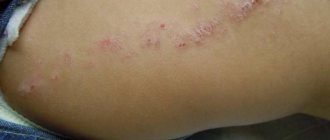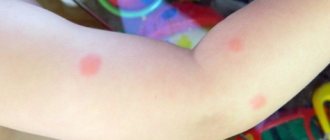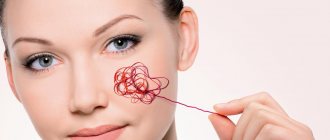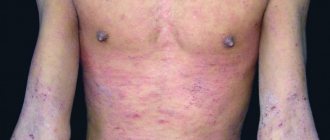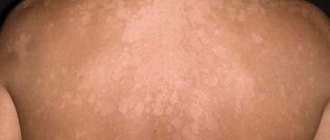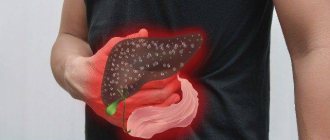What are the reasons
Spots and allergies on the body due to nervousness occur during emotional overstrain.
The main causes of pathology include:
- hereditary predisposition - if older family members suffered, then the trait will be passed on to younger generations;
- increased emotionality, anxiety - these signs are typical for women and children;
- severe overwork, irritability, prolonged exposure to stress.
Certain diseases also cause depletion of the nervous system. As a result, spots or rashes appear on the skin from the nerves. People with diabetes, lupus erythematosus, gastritis, and hypertension often suffer from skin pathologies.
The body tries to fight the disease for a long time. This leads to the formation of spots and other unpleasant consequences.
Vegetative-vascular dystonia and allergic dermatoses also contribute to the appearance of skin pathologies.
Clinical picture of neurodermatitis and features of its treatment
Nervous spots on the body are treated according to one standard regimen, but depending on the severity of the disease and its individual characteristics, the specialist adjusts the medications.
The following drugs are used:
- Calming agents. Nervous tension, irritability, poor sleep only aggravate the situation. Spots are a result, not a cause, and therefore they need to be dealt with only after emotional and mental balance has been restored.
- Immunomodulating drugs. Even frequent and serious stress attacks on an organism with good immunity are not capable of provoking the appearance of chronic spots on the body or requiring special treatment.
- Antihistamines. They allow you to get rid of hidden allergens and stop the symptom of itchy skin irritation.
- External products for direct treatment of rashes or blemishes. Their task is to relieve swelling, inflammation, restore smoothness, natural color and elasticity of the skin.
Important! In case of severe illness, experts recommend their patients to go to the sea. Salty air dries the skin, helps it cope with the problem on its own and relieves nervous tension.
Most often, dermatitis from nervous overstrain is characterized by:
- The appearance of hyperemic rashes on the skin immediately after suffering nervous excitement or overload. The main difference between this pathological condition and other types of dermatitis is that the elements of the rash disappear immediately after the person’s psycho-emotional state has stabilized.
- Itching, peeling and burning of the rash elements. These pathological processes are characteristic of the acute course of the disease.
- Over time, the skin rash turns into blisters that burst, forming a hard crust.
Signs of stains
The exact symptoms depend on the specific disease of the nervous system that caused the spots to appear. Doctors diagnose a number of common symptoms characteristic of nervous excitability.
The clinical picture includes the following factors:
- spots appear on the skin, they itch, causing discomfort. Can form on any part of the body: face, neck, arms, legs, stomach or back;
- redness of the skin, usually hyperemia occurs near the spots;
- The increase in body temperature is usually insignificant. Temperature indicates inflammatory processes occurring in the body;
- a rash on the body due to nervousness is characterized by a general deterioration in the condition of the body;
- increased excitability, nervousness. All this causes an increase in heart rate by 50 - 70%;
- then, in place of the red spots, bubbles or blisters with clear liquid may appear.
Often, the patient is additionally concerned about allergic manifestations. Among them: runny nose, cough, sneezing, tearing, swelling of the skin. Asthmatic complications may be added to this.
If these symptoms appear, you should not self-medicate. Seek help from a dermatologist.
Heart diseases
The list of dermatological ailments that appear as a result of stress is very extensive. Most skin problems arise as a result of a weakened nervous system. Their list includes such manifestations as:
- urticaria (urticaria);
- eczema;
- lichen planus;
- psoriasis, etc.
Painful sensations in the heart area are a symptom that accompanies many mental disorders, but often the heart begins to hurt even under ordinary stress.
Like all nervous diseases, this is a sign that the body is exhausted, tired and needs rest. The heart can tighten painfully when a person constantly experiences feelings of fear, anxiety or melancholy.
Also, psychosomatic pain in the heart occurs in people who lack attention. From life experience, they know that usually seriously ill patients receive a lot of attention from others, so the body subconsciously begins to copy the symptoms characteristic of various heart diseases.
Before starting treatment, it is important to make sure that the cause is truly psychosomatic, since true heart disease is extremely undesirable to neglect. Therefore, you first need to visit a cardiologist. If this does not give results, then the patient should go to a psychologist or psychotherapist, and also try to eliminate stressful situations in life.
The gastrointestinal tract often suffers from stress. Due to disturbances in the functioning of the brain, blood circulation deteriorates, which affects the mucous membrane.
Because of this, gastritis or ulcers may begin to develop. Also, nervous tension causes frequent or, on the contrary, too infrequent contractions of the intestines, diarrhea, constipation and nausea are a common occurrence due to nervousness; in the case of such disorders, pain, burning in the rectum, bloating and other symptoms characteristic of common gastrointestinal diseases may appear.
It is important to start treatment as soon as possible, since nervous gastritis progresses very quickly. Patients are usually prescribed medications that relieve inflammation and help regulate the balance of microflora. A strict diet is required. And psychological problems are resolved at an appointment with an appropriate specialist.
What do different types of stains look like?
Skin diseases occur due to a weakened nervous system. Spots on the legs, arms, face, and body may look different, depending on the disease.
The most common pathologies include:
- Urticaria - in this case, red defects form on the body, similar to traces of nettle burns. Gradually, the spots merge, itch, and cause severe discomfort.
- Eczema is a non-contagious pseudoallergy disease, as a result of which red defects appear on the skin. A certain area of the body turns red, then bubbles with liquid form on it. The papules burst, and serous wells form in their place. The affected area becomes covered with a yellow crust. The disease is chronic.
- Lichen ruber is a disease in which dark red, even bluish blisters form. Ringworm is very itchy and is caused by a nervous disorder.
- Psoriasis is a chronic autoimmune and non-contagious disease. Dermatosis affects the skin and worsens during stressful situations. Plaques form on the body; if they are removed, a thin thermal film will appear. When affected, a sign of blood dew is observed. Droplets of blood form on the affected area of the skin.
You can look at the pathologies and find out the names on photo medical forums. But this information is for informational purposes only. Only a doctor makes a diagnosis.
Hives
Allergic dermatosis, which occurs mainly when taking certain medications and foods.
The disease is quite common. Every third person encounters its acute form at least once during his life. Women aged 20-60 years are most susceptible to it due to the characteristics of their nervous state and hormonal levels. The pathology is characterized by the formation of swollen red spots, similar to nettle burns. Itching also occurs. Treatment consists of eliminating the allergen, taking antihistamines, and external treatment with antipruritic solutions. In the chronic form of urticaria, systemic hormonal therapy is prescribed during periods of exacerbation.
What to do
If spots appear on the skin, you should consult a dermatologist. The doctor will visually assess the patient’s condition and conduct the necessary studies.
Usually you will need the results of general urine and blood tests, scrapings from damaged areas of the body. The doctor will then explain the name of the disease and how to treat it.
Therapy depends on the specific pathology and the reasons that caused the spots to appear. For example, treating psoriasis is completely different from treating hives.
In most cases, people are prescribed to take a course of antihistamines, and vitamin therapy is recommended.
- compliance with the daily routine - doctors advise not to neglect rest, sleep at night for at least eight hours;
- balanced diet – moderate consumption of proteins, fats and carbohydrates. You need to eat more fresh fruits and vegetables, a sufficient amount of fiber, and long-term carbohydrates. Also, don't avoid saturated fats and protein foods;
- Avoid eating food allergens - citrus fruits, honey, nuts. If the patient is allergic to any product, then it must be excluded. It is also recommended not to come into contact with non-food irritants (washing powders, soaps and shower gels with strong odors);
- strengthening the immune system through hardening, walking in the fresh air, sunbathing;
- regular exercise – if the patient is unable to do physical activity in the gym or swimming pool, then it is recommended to take daily walks or ride a bicycle.
One of the most important stages in treatment is avoiding stressful situations. For this, doctors prescribe sedatives.
Traditional methods
- Take 100 grams of flax seed, pour in 3 liters of water. Place on fire and boil. Cook over low heat, remove after 10 minutes. Add the decoction to a bath of warm water.
- Combine equal parts of a mixture of chamomile, string and oak bark. Pour 3 tablespoons of the mixture into a liter of cold water. Leave for 12 hours, then boil. Take a bath with this decoction, in a ratio of 1 part infusion to 10 parts clean water.
- A baking soda bath will help with hives. Add a glass of powder to a bath of warm water. This will help relieve severe itching and swelling.
Root causes of itching
Stress can affect more than just your emotional health. The reaction to overexertion causes a wide range of physical symptoms, such as rashes, dystrophic changes in the nails, and exacerbation of chronic diseases. Rashes can appear on any part of the body.
After recovery, no traces remain - this confirms that the cause of dermatitis is nerves.
Scientists have proven that strong emotional experiences are associated with the appearance of acne or nettle fever. Areas of skin affected by dermatitis are red, inflamed, and swollen.
The spots can be the size of a pencil tip or the size of a five-ruble coin. People with allergies, neurodermatitis or sensitive, easily irritated skin should pay attention to intensive care.
Vitiligo
Pigmentation disorder, expressed in the destruction of melanin in some areas of the skin. Causes the appearance of white spots from nerves. In addition to neurogenic factors, pathology can be provoked by immune and hormonal disorders. The cause may also be exposure to drugs and chemicals, inflammation and suppuration.
Most often, the disease occurs at a young age and is not accompanied by physical discomfort. The spots form primarily on the hands, elbows and knees. They tend to grow and spread. The hair over the depigmented areas turns grey. There is no reliable treatment method. Antioxidants and immunomodulators are used as therapy.
Symptoms of a nervous rash
Skin rashes are a common physical symptom of stress. Everyday forms of stressful situations have little effect on the body. Nervous exhaustion leads to dermatitis and allergic reactions, manifested by the following symptoms:
- skin rashes (wet, dry, flaky);
- anxiety;
- itching;
- incessant burning;
- the appearance of blisters;
- shiver;
- decreased mood;
- sneezing;
- drowsiness.
Repetitive stress and facial skin are closely related. Eliminating the main symptoms will restore health to the skin.
Types of nerve rash
Stress spots and rashes are localized on one part of the body and then move to another, covering a larger area. The rash comes in different forms. Stress can prevent existing skin problems (psoriasis, eczema) from healing properly. The affected areas itch and cause discomfort.
A nervous allergy is considered acute if it resolves after 9 weeks. When symptoms cannot be completely and permanently cured, the condition is considered chronic.
Nerve allergies
Research has shown that stress increases allergic reactions. Addressing anxious behavior will reduce sensitivity to allergies.
The following symptoms indicate a nervous allergy:
- chills;
- fever;
- oppression;
- spots and pimples appear on the skin;
- irritation of any area of the body, causing the desire to itch.
To prevent environmental and psychological factors from putting too much strain on the skin, it is necessary to maintain its moisture and elasticity.
Hives
Hives are considered a common type of rash characterized by the formation of raised, red, itchy patches on the skin. The cause and severity of the condition varies; only specialists will be able to find the cause of the spots.
Nerve allergies are the main cause of hives. This occurs when the immune system reacts abnormally to a harmless substance and floods the body with an inflammatory chemical (histamine). In addition to physical stimuli, nervous disorders are associated with the development or worsening of chronic rashes.
The exact cause is unknown, but the release of stress hormones such as cortisol is thought to cause an indirect effect in which the underlying cause of the spots is activated.
Symptoms indicating nettle fever:
- itching and burning;
- bright scarlet spots that quickly begin to increase in size.
The appearance of any of the signs of the disease requires consultation with a specialized specialist. In some cases, hives become potentially life-threatening.
Nervous scabies
Only a specialist can make an accurate diagnosis. Scabies caused by a nervous imbalance can be identified by the following symptoms:
- increased body temperature;
- anxiety;
- nervousness;
- causeless tears;
- itchy small red spots.
If the itching becomes obsessive, the doctor will prescribe special medications that reduce excitability. At home, a person affected by neurogenic scabies can use traditional methods of treatment:
- herbal decoctions (St. John's wort, chamomile, motherwort), which should be taken before meals;
- ointments made from beeswax and tar.
A combination of anti-anxiety therapy and lifestyle changes will help get rid of nervous scabies.
Nervous psoriasis and eczema
Psoriasis and eczema are similar chronic diseases that require an effective method of ongoing management of associated stress. Management methods help control skin rashes:
- doing exercises is an effective means of relieving stress;
- avoiding alcohol and drugs that only worsen anxiety;
- identifying the main sources of the problem - this will help control them.
Patients with eczema and psoriasis need to develop a “survival” mechanism. The psychological attitude plays a primary role in this.
Symptoms indicating the appearance of pathologies:
- endless itching;
- peeling;
- dry skin;
- scales (psoriatic plaques);
- change of mood;
- apathy.
Doctors and researchers do not yet fully understand what causes eczema to develop. Psoriasis is an autoimmune disease that occurs when the immune system is weakened.
Eczema
A chronic skin disease that occurs due to disruption of the nervous and endocrine systems, gastrointestinal diseases, infectious lesions and a tendency to allergies. There is a dry form, in which the affected areas peel off, and a wet form, accompanied by the formation of small watery blisters on the spots.
There are several types of eczema, each with specific symptoms. A common symptom is severe itching. Normalization of nutrition and lifestyle plays an important role in treatment. Drug therapy consists of taking sedatives, antihistamines, vitamins and immunomodulators. Hormonal and anti-inflammatory ointments are applied locally.
Treatment of nervous rashes
Most allergic reactions to stress go away on their own, i.e. without treatment. Skin areas can be treated well at home. A common treatment is an over-the-counter (OTC) drug.
Antihistamines relieve symptoms such as itching, quickly block receptors, and are available at reasonable prices.
Over-the-counter medicines:
- Diphenhydramine;
- Diazolin;
- Tavegil;
- Cetirizine (Zyrtec);
- Fexofenadine (Allegra);
- Loratadine;
- Claritin;
- Xizal;
- Suprastin;
- Oral anti-itch medications.
At home, a cool compress applied to the affected areas will help stop the development of an allergic reaction. Skin after stress requires additional care and attention.
Possible Causes of Red Spots from Anxiety
Skin reactions are often the first sign of illness and are associated with some very serious physical ailments. We are told at a young age to be careful with any rashes or red bumps because they can be a sign of:
- Chickenpox
- measles
- pigs
- Allergic reactions to medications
As we get older, we are told to keep an eye out for changes in skin health because it could be a sign that something is wrong. Some spots on the skin indicate cancer - which is why, if you're concerned, you should see a doctor to find out if the rash is a sign of something more. Only a doctor can diagnose the cause of red spots.
But the reality of visible skin rashes and ailments is that sometimes they are not caused by anything. Your skin can react to all sorts of chemicals, hormones—even temperature. Some people get a very severe rash for no apparent reason.
Many red spots have no underlying health reason, while others are caused by anxiety. Anxiety can cause red spots in several ways:
Body temperature
The most likely cause of red blotchy skin is an increase in body heat. During times of intense stress and anxiety, your body heats up and this releases a chemical in your body known as histamine—the same immune chemical released during an allergic reaction. As histamine rises to the surface, your body creates “hives,” which often appear as itchy red patches on the skin.
Temperature-related spots can cause rashes anywhere on your body, but the most common are:
Sweating
Anxiety also causes sweating. Sweating can lead to the same release of histamine, which is the same as an increase in body heat. But it can also lead to another skin rash known as miliaria (not to be confused with malaria). Miliaria is a simple sweaty rash that can affect many people who suffer from severe anxiety attacks.
Skin irritation
Those who previously had massive blemishes on their skin may find that their skin condition becomes irritated as a result of anxiety. For example, those who have had chickenpox in the past may be more prone to shingles outbreaks. Chickenpox is related to the herpes virus, and like herpes, it never leaves your body. During times of intense stress, the virus becomes more prone to activation and it can rise to the surface and lead to a very itchy and painful outbreak known as shingles.
Psoriasis
A non-infectious dermatological disease that causes spots on the skin from nerves. Characterized by faster formation and death of cells. The main reasons include heredity, impaired immunity, metabolism, and neuroendocrine factors. About 4% of the population suffers from the pathology, most of whom are young people under 20 years of age.
The main symptom is the appearance of red, itchy areas of inflammation. Their surface peels off. The top layer of scales is easily removed; scraping the bottom layer leads to bleeding. The lesions are mainly localized on the head, knee and elbow bends, in the groin area and on the back. In 25% of cases, nails are affected. Antihistamines, sedatives, and anti-inflammatory drugs are used for treatment. Physiotherapeutic procedures are also used.
How to cure these red spots
Whether you can stop the red spots from appearing or not depends on the cause of their appearance. If your anxiety was irritated by some type of skin condition - like shingles - then you just need to wait until it heals itself naturally, or treats the underlying virus that caused the reaction.
But if your red spots are caused by histamine, then the solution becomes a little easier.
Short-term anxiety control
In many cases, the histamine activation is temporary and will subside by the time you get your anxiety under control. If you are experiencing a severe anxiety attack, try the following:
- Slow breathing. Many anxiety symptoms are caused by breathing too quickly. An anxiety attack can make you feel like you're not taking deep breaths, and the tendency to over-breathe worsens your anxiety symptoms. A good way to control them is to slow down your breathing so your body can restore its carbon dioxide balance. Deep breathing exercises may also be helpful.
- Distract your senses. Try to find a healthy distraction. If you have a friend, you can call and talk to him on the phone. These activities take you out of your head so you focus less on how you're feeling and more on the conversation (or any other distraction). This usually calms the nerves and leads to less anxiety.
- Reward yourself. Often when people have red spots, they are afraid of embarrassment. Unfortunately, this fear only causes additional anxiety. Your ability to simply tell yourself "no matter what they think of me, I don't care about these stains" and go about your day anyway will reduce that extra stress that comes with trying to hide the stains and worrying about the fear.
Intimate problems
Very often, people experience intimate problems precisely because of nervousness, and both men and women suffer from this. As a rule, because of this, sexual contacts either do not bring pleasure or become impossible. There may be several reasons.
Constant fatigue and tension contribute to the fact that a person ceases to experience sexual desire. Some people are hampered by complexes, self-doubt, fear of doing something wrong or embarrassing themselves in front of a partner. The reason may also be previous failures in your personal life.
All these problems can be treated in only one way - psychoanalysis. A person needs to understand himself, get rid of complexes and stress. Consulting a sexologist and psychologist can help.
Why do spots appear on the body?
According to medical indications, exhaustion of the nervous system aggravates not only the psycho-emotional state, but also the physical one. Various diseases can appear due to nervousness:
- Diabetes.
- Hypertension.
- Lupus.
- Vegetovascular dystonia.
- Gastritis, which later turns into a stomach ulcer.
- Allergic dermatoses.
All of the above ailments are a closed form of the disease, but the latter, unfortunately, cannot be hidden.
The appearance of spots on the body is one of the most unpleasant and discomforting diseases. After a lot of stress, the human body becomes exhausted. There are obvious changes in the general condition.
As a rule, the main indicator of nervousness is skin rashes on the body, appearing in the form of rashes, spots, blisters.
Areas where an allergic reaction due to nerves may occur:
- Face (cheeks, forehead, chin).
- Neck.
- Extremities (arms, legs).
- Body (stomach, chest).
Spots on the body can develop into other, more complex allergic diseases, possibly becoming chronic.
List of skin diseases:
- Small red spots that are itchy (urticaria).
- Scales, papules on inflamed skin (eczema).
- Dark red nodules affecting certain areas of the skin (lichen).
- Dry, overgrown plaques (psoriasis).
- White spots on dark skin (vitiligo).
There are many skin diseases due to nervous soil. The nature and form of the disease depends on the characteristics of the person.
Predisposing factors
Skin diseases provoked by emotional disturbances are in most cases recorded in young children and hysterical women, and pregnant women.
In most cases, pathologies are temporary. However, medicine knows cases of the chronic course of such pathologies associated with unfavorable working conditions and individual characteristics of the human nervous system.
Among the most common reasons leading to the appearance of spots are:
- mental and emotional overload;
- depression;
- irritability or aggression;
- chronic lack of sleep;
- fears;
- disturbances in the cardiovascular, endocrine or digestive systems;
- decreased immunity;
- hormonal imbalances;
- general intoxication.
Experts assign a special role to chronic diseases. Thanks to them, a person experiences constant discomfort, and the treatment gradually poisons the body. In combination with even a slight lack of sleep or worries about any reason, all these factors can become an excellent basis for the development of dermatological pathologies based on the nervous system.

